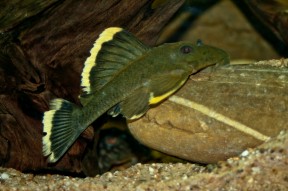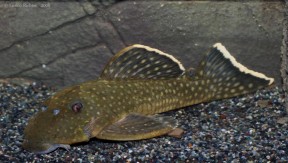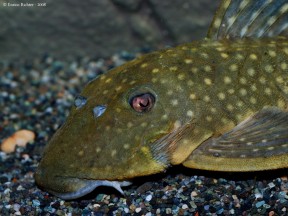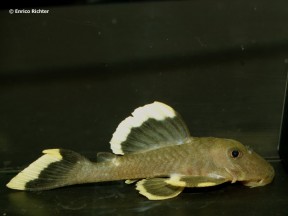Baryancistrus chrysolomus
Mango Pleco, L047
Classification
Order: Siluriformes Family: Loricariidae
Distribution
Endemic to the rio Xingu basin in Pará state, Brazil, where it inhabits a section of the river’s main channel known as ‘Volta Grande do rio Xingu’ directly above Belo Monte falls. It’s also been collected in the upper rio Curuá, a tributary of the rio Iriri which is itself an affluent of the Xingu.
Habitat
Often collected from whitewater rapids although appears to show a preference for stiller habitats with young specimens observed to shelter under rocks in marginal zones with slow to moderately-flowing water. Adults were found under larger, flat rocks on the bed of the river. Syntopic fishes included Peckoltia vittata and an unidentified Hypostomus sp.
Maximum Standard Length
The largest specimen in the type series measured 219 mm.
Aquarium SizeTop ↑
Given the adult size an aquarium with base dimensions of 120 ∗ 45 cm or equivalent should be the smallest considered for long-term maintenance.
Maintenance
Not difficult to maintain under the correct conditions but largely unsuitable for the ‘general’ community aquarium. We recommend keeping it in a set-up designed to resemble a flowing river with a substrate of variably-sized rocks, gravel and some large water-worn boulders.
This can be further furnished with driftwood branches, roots and tough aquatic plants such as Microsorum, Bolbitis, or Anubias spp., which can be grown attached to the décor. Bright lighting will promote the growth of aufwuchs upon which the fish will graze.
Like many species that naturally inhabit running waters it’s intolerant to the accumulation of organic wastes and requires spotless water at all times in order to thrive. It’s also essential to provide sufficient levels of dissolved oxygen and water movement using a combination of canister filters, powerheads, etc., particularly if the aim is for the fish to breed. Weekly water changes of 40-70% should also be considered mandatory.
Water Conditions
Temperature: 27 – 32 °C; this species will not thrive in cooler water.
pH: 6.0 – 7.5
Hardness: 36 – 215 ppm
Diet
Gut analyses of wild specimens revealed the diet to be composed chiefly of algae, particularly diatoms and filamentous genera such as Spirogyra alongside smaller amounts of invertebrates such as chironomids and bryozoans.
In the aquarium aufwuchs should thus be allowed to colonise all surfaces except the viewing pane so that the fish can browse naturally although the diet should of course be supplemented with high-quality, sinking dried foods (preferably with added vegetable content), live or frozen bloodworm and similar, plus slices of fresh fruit and vegetables and the occasional defrosted prawn or shrimp.
Home-made, gelatine-bound recipes containing a mixture of puréed fish food, shellfish, fruit and vegetables, are also proven to work well and in many ways represent the ideal staple diet since the ingredients can be altered at will, and when made well such foods contain a greater concentration and diversity of nutrients than any of the other options.
Baryancistrus spp. are often under-nourished and/or suffering from health issues post-importation and may require an extended period of quarantine and acclimatisation. They also have a relatively high metabolic rate and may initially require several meals per day.
Behaviour and CompatibilityTop ↑
Juveniles are relatively peaceful but males in particular become highly intolerant of conspecifics as they age and typically aggressive towards any other fish viewed as a territorial threat.
It’s therefore best kept with species that inhabit other areas of the tank with medium-to-large sized characids particularly suitable. In very large aquaria you may be able to combine it with other catfishes or maintain a group provided care is taken to provide sufficient territorial space and visual barriers when laying out the décor.
Sexual Dimorphism
Very difficult to sex. Mature females are slightly rounder in the forehead and belly than males.
Reproduction
Unreported.
NotesTop ↑
Prior to description this species was traded under the DATZ code L047 or the alternative vernacular name ‘magnum pleco’. It can be distinguished from congeners by a combination of the following characters: presence of a broad, light-coloured (usually yellowish) distal band on the dorsal and caudal fins throughout life, slightly reduced in adults.
The only other member of the genus to possess such bands is B. xanthellus but in that species they are reduced to small markings at the fin tips in adults, and the body is covered in pale, normally yellowish, spots. While some specimens of B. chrysolomus do display pale spots on the body they are never as prominent or brightly-coloured.
The genus Baryancistrus can be distinguished from all other loricariids by possession of an enlarged membrane located posteriorly to the last branched dorsal-fin ray. This membrane may or may not reach the supporting structure of the adipose fin and in this way members can be told apart from the genera Oligancistrus, Parancistrus, and Spectracanthicus, in which the dorsal and adipose fins are completely connected, and Hemiancistrus in which the membrane is not well-developed.
The family Loricariidae is the largest among catfishes with over 700 species described to date and many awaiting description. The latter are typically assigned a specific ‘L’ number by hobbyists and scientists alike in order to provide a basic means of identification, although in some cases several species have been referred to the same number, or multiple numbers have been used for different populations of a single taxon. All loricariids are also commonly referred to as ‘pleco’, ‘plecostomus’, or ‘suckermouth armoured catfishes’.
The closer relationships of member genera have long been of interest to icthyologists but in numerous cases remain unresolved. Isbrücker (1980) was the first to propose an arrangement of six subfamilies, namely Lithogeneinae, Neoplecostominae, Hypostominae, Ancistrinae, Hypoptopomatinae, and Loricariinae, and this model was generally followed until publication of Armbruster’s morphological analysis in 2004.
His phylogeny also contained six subfamiles, with Isbrücker’s (1980) Ancistrinae being included as one of five tribes comprising Hypostominae. This was later modified slightly by Reis et al. (2006) and an adapted version of their key is reproduced here:
1a. No lateral and dorsal plates anterior to the dorsal fin: Lithogeneinae
1b. Possession of lateral plates anterior to the dorsal fin (except in Pareioraphis nudulus): 2
2a. Ventral surface of the pectoral girdle exposed (i.e. supporting odontodes) towards the centre of the coracoid strut: Hypoptopomatinae
2b. Ventral surface of the pectoral girdle covered in skin or plates towards the centre of the coracoid strut (odontodes supported by the plates rather than the girdle): 3
3a. Caudal peduncle flattened dorsoventrally; no adipose fin: Loricariinae
3b. Caudal peduncle oval, round, or triangular in cross-section; adipose fin usually present: 4
4a. Postdorsal ridge formed from several preadipose plates arranged singly. Teeth almost symmetrically bifid (divided into two equal parts): Delturinae
4b. Usually no postdorsal ridge. Teeth asymmetrical or unicuspid: 5
5a. Dorsal–fin spinelet V-shaped, dorsal–fin spine can be locked: Hypostominae
5b. Dorsal–fin spinelet rectangular or absent, dorsal–fin spine cannot be locked: Neoplecostominae
Subsequent papers attempting to resolve relationships within the Hypoptopomatinae and Neoplecostominae by Cramer et al. (2008, 2011) have revealed both subfamiles to be polyphyletic arrangements alongside several genera, e.g., Pareiorhaphis, Pareiorhina, Hisonotus, and Parotocinclus, so there is evidently a great deal of work still to be done. At any rate Baryancistrus is currently considered a member of the tribe Ancistrini within Hypostominae.
The sucking disc formed by the mouthparts is common to all representatives but both oral and dental morphology are highly variable depending on a given species‘ ecological adaptation(s), with some even practising xylophagy (wood-eating). Many are also facultative air-breathers, i.e., they possess the ability to respire atmospheric air if necessary.
References
- Rapp Py-Daniel, L. , J. Zuanon, and R. Ribeiro de Oliveira, 2011 - Neotropical Ichthyology 9(2): 241-252
Two new ornamental loricariid catfishes of Baryancistrus from rio Xingu drainage (Siluriformes: Hypostominae). - Armbruster, J. W., 2008 - Zootaxa 1822: 1-76
The genus Peckoltia with the description of two new species and a reanalysis of the phylogeny of the genera of the Hypostominae (Siluriformes: Loricariidae). - Armbruster, J. W. , 2004 - Zoological Journal of the Linnean Society 141: 1-80
Phylogenetic relationships of the suckermouth armoured catfishes (Loricariidae) with emphasis on the Hypostominae and the Ancistrinae. - Cramer, C. A., A. M. R. Liedke, S. L. Bonatto, and R. E. Reis, 2008 - Bulletin of Fish Biology 9: 51-59
The phylogenetic relationships of the Hypoptopomatinae and Neoplecostominae (Siluriformes: 725 Loricariidae) as inferred from mitochondrial cytochrome c oxidase I sequences. - Cramer, C. A., S. L. Bonatto, and R. E. Reis, 2011 - Molecular Phylogenetics and Evolution 59(1): 43-52
Molecular phylogeny of the Neoplecostominae and Hypoptopomatinae (Siluriformes: Loricariidae) using multiple genes. - Lujan, N. K., M. Arce, and J. W. Armbruster, 2009 - Copeia 2009(1): 50-56
A new black Baryancistrus with blue sheen from the upper Orinoco (Siluriformes: Loricariidae). - Reis, R. E., E. H. L. Pereira, and J. W. Armbruster, 2006 - Zoological Journal of the Linnean Society 147(2): 277-299
Delturinae, a new loricariid catfish subfamily (Teleostei, Siluriformes), with revisions of Delturus and Hemipsilichthys. - Werneke, D. C. , M. H. Sabaj Pérez, N. K. Lujan and J. W. Armbruster, 2005 - Neotropical Ichthyology 3(4): 533-542
Baryancistrus demantoides and Hemiancistrus subviridis, two new uniquely colored species of catfishes from Venezuela (Siluriformes: Loricariidae).





